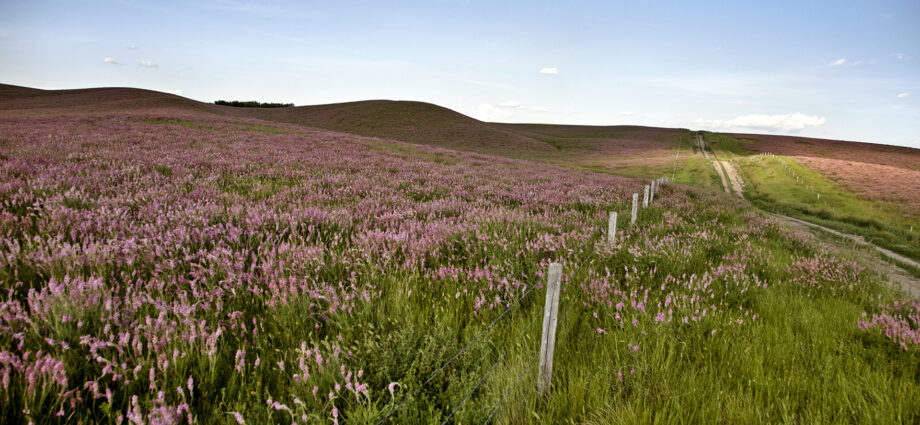
Rotating alfalfa, flax and other unharvested crops can sequester carbon efficiently and increase farm resilience, but cost is a barrier for farmers.
by Claire Davies. Originally published on Policy Options
June 29, 2023
Canada’s agricultural sector is threatened by a changing and increasingly variable climate. Longer and more frequent adverse conditions such as droughts and floods are leading to soil erosion and biodiversity loss, which then reduce yields, increase costs, and challenge the ability of farmers to sustain food production.
Canada is at a pivotal time. One path to help meet the dual objectives of reducing greenhouse gas (GHG) emissions and adapting to climate impacts is to increase farmers’ adoption of cover crops – a nature-based solution, the term for actions or policies that harness nature to combat climate change and other pressing issues.
Farmers under-invest in cover crops because of the cost, amongst other barriers. There are few ways to be compensated for them. But the federal government could take specific steps to address this market failure and facilitate investment.
Cover crops are unharvested crops grown in rotation to sustain, recover or enhance desirable ecological attributes that may be lacking in agro-ecosystems. The species or cover-crop mixes, the seeding method, rate, and timing can be adapted for conditions such as the soil and agro-climatic zones and farmers’ long-term objectives. Cover crops include legumes such as alfalfa and clover; grasses such as ryegrass and barley; brassicas such as radishes and turnips; and non-legume broadleaves such as spinach and flax. Their variety and flexibility allow farmers to tailor the crops’ application to their needs.
Cover crops can provide a variety of ecosystem services that benefit farmers directly such as retaining moisture and nitrogen in the soil, improving soil health, slowing soil erosion, and increasing field and/or crop resilience. They can also be part of annual farming cycles and do not require new technologies, different capital equipment or other major expenses.
They also produce cost-effective carbon sequestration. A Canadian study finds that cover crops can sequester up to half a ton of carbon per hectare per year with an average abatement cost that is considerably lower than many other means of sequestering carbon. Economists at Farmers for Climate Solutions, a coalition of Canadian farmers and supporters working on climate change, estimate the average GHG abatement cost associated with greater use of cover crops is $51 per ton of carbon dioxide equivalent – an amount lower than many other methods of sequestering carbon.
But the extent to which farmers are willing and able to invest in cover crops is defined largely by compounding factors, which are not experienced equally by all farmers. The unique financial, physical, and human and social circumstances in which farmers operate can considerably constrain action. Knowledge, policy, and regulatory conditions also influence whether cover crops are used.
Let’s seize this historic opportunity in our agriculture sector
Beware the glitz of neo-industrial agriculture
Canadian agriculture cannot become an innovation engine without competition
Furthermore, the success of cover crops in reducing GHG emissions and increasing the resilience of a farm depends on field level conditions (i.e., physical, environmental) and structural conditions (i.e., financial, knowledge, human and social capital). Social capital may include the presence of community leadership and social networks. Subjective social norms also factor in, including the challenges or inaction of neighbours as well as any negative perceptions or distrust of government programs. The effectiveness of cover crops is, therefore, context-specific, and their performance over time will vary depending on the decisions of individual farmers.
Farmers are more likely to adopt cover crops if public policy can provide incentives, such as financing for ecosystem services and reducing/removing barriers.
Here are three ways the federal government can encourage cover crops:
Establish a federal cover-crop advisory committee
The advisory committee could identify and communicate opportunities for increasing the adoption of cover crops across Canada. The committee could also provide expert advice on the delivery of provincial programs related to reducing barriers to cover-crop adoption, and could work closely with existing regional agricultural advisory committees across the country. Establishing the advisory committee is a first step in building trust, sharing knowledge and research findings, and designing policy.
Increase science-based research funding to academic institutions
All farmers, including equity-deserving groups, could benefit from more research and information. Any costs and potential co-ordination challenges should be relatively low. Farmers support this option, as indicated in the existing literature and interviews from my research.
Increase funding for cover-crop adoption
More funding (in the form of per-acre payments, for example) could help financially compensate farmers for their ecological services and address some equity concerns. Financial incentives are the most effective method to increase the adoption of nature-based solutions.
Cover crops present an overlooked opportunity for Canada’s agriculture sector to effectively mitigate GHGs and adapt to climate change, ultimately enhancing its resilience. These three policy recommendations are a good place to start.
Subscribe to our newsletter.
This article first appeared on Policy Options and is republished here under a Creative Commons license.

